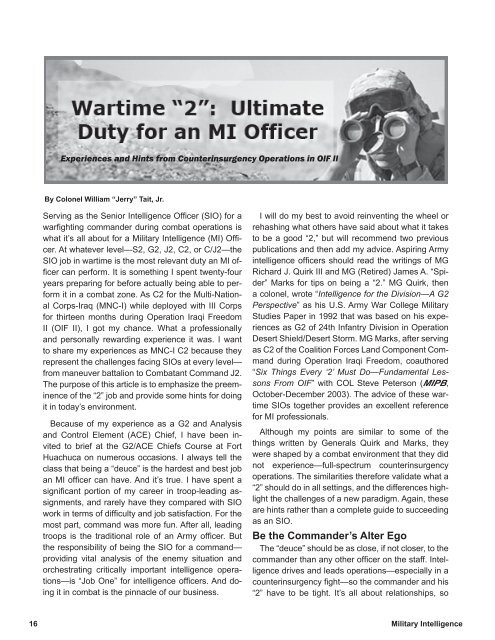Military Intelligence Professional Bulletin - Federation of American ...
Military Intelligence Professional Bulletin - Federation of American ...
Military Intelligence Professional Bulletin - Federation of American ...
You also want an ePaper? Increase the reach of your titles
YUMPU automatically turns print PDFs into web optimized ePapers that Google loves.
16<br />
Experiences and Hints from Counterinsurgency Operations in OIF II<br />
By Colonel William “Jerry” Tait, Jr.<br />
Serving as the Senior <strong>Intelligence</strong> Officer (SIO) for a<br />
warfighting commander during combat operations is<br />
what it’s all about for a <strong>Military</strong> <strong>Intelligence</strong> (MI) Officer.<br />
At whatever level—S2, G2, J2, C2, or C/J2—the<br />
SIO job in wartime is the most relevant duty an MI <strong>of</strong>ficer<br />
can perform. It is something I spent twenty-four<br />
years preparing for before actually being able to perform<br />
it in a combat zone. As C2 for the Multi-National<br />
Corps-Iraq (MNC-I) while deployed with III Corps<br />
for thirteen months during Operation Iraqi Freedom<br />
II (OIF II), I got my chance. What a pr<strong>of</strong>essionally<br />
and personally rewarding experience it was. I want<br />
to share my experiences as MNC-I C2 because they<br />
represent the challenges facing SIOs at every level—<br />
from maneuver battalion to Combatant Command J2.<br />
The purpose <strong>of</strong> this article is to emphasize the preeminence<br />
<strong>of</strong> the “2” job and provide some hints for doing<br />
it in today’s environment.<br />
Because <strong>of</strong> my experience as a G2 and Analysis<br />
and Control Element (ACE) Chief, I have been invited<br />
to brief at the G2/ACE Chiefs Course at Fort<br />
Huachuca on numerous occasions. I always tell the<br />
class that being a “deuce” is the hardest and best job<br />
an MI <strong>of</strong>ficer can have. And it’s true. I have spent a<br />
significant portion <strong>of</strong> my career in troop-leading assignments,<br />
and rarely have they compared with SIO<br />
work in terms <strong>of</strong> difficulty and job satisfaction. For the<br />
most part, command was more fun. After all, leading<br />
troops is the traditional role <strong>of</strong> an Army <strong>of</strong>ficer. But<br />
the responsibility <strong>of</strong> being the SIO for a command—<br />
providing vital analysis <strong>of</strong> the enemy situation and<br />
orchestrating critically important intelligence operations—is<br />
“Job One” for intelligence <strong>of</strong>ficers. And doing<br />
it in combat is the pinnacle <strong>of</strong> our business.<br />
I will do my best to avoid reinventing the wheel or<br />
rehashing what others have said about what it takes<br />
to be a good “2,” but will recommend two previous<br />
publications and then add my advice. Aspiring Army<br />
intelligence <strong>of</strong>ficers should read the writings <strong>of</strong> MG<br />
Richard J. Quirk III and MG (Retired) James A. “Spider”<br />
Marks for tips on being a “2.” MG Quirk, then<br />
a colonel, wrote “<strong>Intelligence</strong> for the Division—A G2<br />
Perspective” as his U.S. Army War College <strong>Military</strong><br />
Studies Paper in 1992 that was based on his experiences<br />
as G2 <strong>of</strong> 24th Infantry Division in Operation<br />
Desert Shield/Desert Storm. MG Marks, after serving<br />
as C2 <strong>of</strong> the Coalition Forces Land Component Command<br />
during Operation Iraqi Freedom, coauthored<br />
“Six Things Every ‘2’ Must Do—Fundamental Lessons<br />
From OIF” with COL Steve Peterson (MIPB,<br />
October-December 2003). The advice <strong>of</strong> these wartime<br />
SIOs together provides an excellent reference<br />
for MI pr<strong>of</strong>essionals.<br />
Although my points are similar to some <strong>of</strong> the<br />
things written by Generals Quirk and Marks, they<br />
were shaped by a combat environment that they did<br />
not experience—full-spectrum counterinsurgency<br />
operations. The similarities therefore validate what a<br />
“2” should do in all settings, and the differences highlight<br />
the challenges <strong>of</strong> a new paradigm. Again, these<br />
are hints rather than a complete guide to succeeding<br />
as an SIO.<br />
Be the Commander’s Alter Ego<br />
The “deuce” should be as close, if not closer, to the<br />
commander than any other <strong>of</strong>ficer on the staff. <strong>Intelligence</strong><br />
drives and leads operations—especially in a<br />
counterinsurgency fight—so the commander and his<br />
“2” have to be tight. It’s all about relationships, so<br />
<strong>Military</strong> <strong>Intelligence</strong>
















